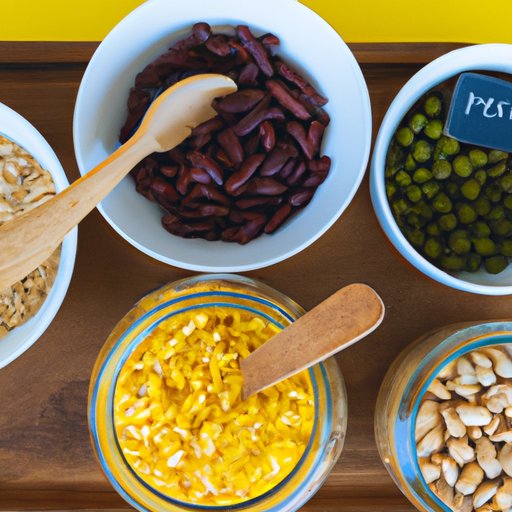
I. Introduction
Do you find yourself often succumbing to the convenience of fast food and processed meals? Are you struggling to incorporate healthy meals into your daily routine? You are not alone. Many people face the challenge of making nutritious choices while juggling busy schedules. This article offers a comprehensive guide on how to eat to live, providing practical tips and advice for developing healthy and sustainable eating habits.
II. 7 Simple Ways to Incorporate Nutritious Meals into Your Daily Routine
Incorporating nutritious meals in your daily routine doesn’t have to be difficult. By following these simple tips, you can create healthy and satisfying meals without sacrificing convenience.
- Batch cook meals in advance, so you always have a healthy option on hand.
- Swap processed snacks for fresh fruits, nuts, and seeds.
- Make use of a slow cooker for easy and flavorful meals.
- Invest in a good-quality blender for preparing smoothies and homemade sauces.
- Try meatless meals with plant-based protein sources like quinoa, lentils, and chickpeas.
- Experiment with different spices and herbs for added flavor to your meals.
- Incorporate at least one serving of fruits and vegetables into every meal.
Examples of easy and quick-to-prepare meals include overnight oats with fruits and nuts, veggie-packed salads, and quinoa bowls with roasted vegetables. By planning your meals in advance and using fresh, whole ingredients, you can create nutritious meals that are also delicious and satisfying.
III. Healthy Eating Habits for a Lifelong Vitality
The key to maintaining lifelong vitality is through healthy eating habits. The food you eat impacts your health and well-being, and a balanced and nutritious diet is essential for preventing chronic diseases and promoting overall wellness.
To develop healthy eating habits, prioritize whole, unprocessed foods, and focus on consuming a variety of nutrient-dense foods, including fruits, vegetables, whole grains, and lean proteins. Avoid processed foods, added sugars, and unhealthy fats. And, of course, stay hydrated by drinking plenty of water throughout the day.
Developing a healthy and sustainable eating plan that works for you is the first step towards maintaining good health throughout your life. Seek guidance from a registered dietitian or healthcare professional for personalized advice.
IV. The Ultimate Guide to A Balanced Diet
A balanced diet is one that includes a variety of foods from all the different food groups in the right proportions, supplying the necessary nutrients for overall health. The different food groups include carbohydrates, proteins, fats, vitamins, and minerals.
To maintain a balanced diet, aim for:
- Whole grains, such as brown rice, quinoa, and whole-grain bread.
- Lean proteins, such as chicken, fish, lentils, and tofu.
- Healthy fats, such as avocado, nuts, and olive oil.
- Colorful fruits and vegetables.
- Dairy or dairy alternatives, such as milk, cheese, or plant-based milk.
Aim to have a colorful plate at every meal, incorporating different food groups to ensure adequate nutrition. A balanced diet helps reduce the risk of chronic diseases such as obesity, heart disease, and diabetes, among others.
V. Eat the Rainbow: A Guide to Colorful and Nutritious Meals
Eating a variety of colorful fruits and vegetables is crucial for optimal health. Different colors indicate different nutrients, and incorporating them into your diet ensures you get all the necessary nutrients needed to maintain good health.
Some of the health benefits of eating a variety of colorful fruits and vegetables include:
- Improved digestion
- Boosted immune system
- Lowered risk of chronic diseases
- Better eye health
- Reduced inflammation
- Improved mood
To incorporate colorful meals daily, try recipes like rainbow salads, stir-fries, and roasted vegetable medleys. Explore different fruits and vegetables and experiment with various cooking methods to find what you enjoy the most.
VI. Mindful Eating: Introduction to Savoring Food and Boosting Health
Mindful Eating is an approach to eating that emphasizes savoring the food, being present in the moment, and concerning one’s self with how the body responds. It encourages one to become aware of their hunger and fullness cues and to appreciate the sensory experience of eating.
The benefits of Mindful Eating include:
- Prevention of binge or emotional eating
- Improved digestion
- Reduced stress levels
- Lowered risk of disordered eating
- Improved self-awareness
Practical tips for practicing Mindful Eating include taking time to prepare meals, eliminating distractions while eating, paying attention to hunger and fullness cues, and savoring the flavors and textures of food.

VII. The Benefits of Eating Clean and How to Start Today
Eating clean is a commitment to consuming whole, unprocessed foods that benefit the body. Processed and refined foods contain added sugars, unhealthy fats, and other additives that can be detrimental to good health.
The benefits of eating clean include:
- Improved digestion
- Better weight management
- Increase in energy levels
- Enhanced mental clarity
- Better sleep quality
- Lowered risk of chronic diseases
To start eating clean, begin by planning meals and snacks in advance, eliminating processed and packaged foods from your diet, and choosing whole, unprocessed foods whenever possible. Shop for fresh fruits and vegetables, lean proteins, and whole grains. Always read ingredient labels and avoid added sugars, unhealthy fats, and artificial additives.
VIII. Meal Planning 101: How to Eat to Live and Save Time in the Kitchen
Meal planning is an effective way to eat healthily, save time and money, and prevent food waste. It involves planning out meals and snacks in advance and preparing them in bulk for the week.
The benefits of meal planning include:
- Easy and efficient meal preparation
- Minimization of food waste
- Cost-effective
- Improved portion control
- Healthier food choices
Start meal planning by selecting recipes, preparing a detailed grocery list, and dedicating a few hours to cooking meals ahead of time. Store them in the fridge or freezer and reheat as needed throughout the week.
IX. Conclusion
Incorporating nutritious meals into your daily routine is crucial for good health and well-being. By following the steps outlined in this comprehensive guide to eating well, you can create sustainable and healthy habits that will last a lifetime. Remember to prioritize whole, unprocessed foods, stay hydrated, and find joy in the preparation and consumption of food. Start today and embark on a journey to a healthy and vibrant life.





